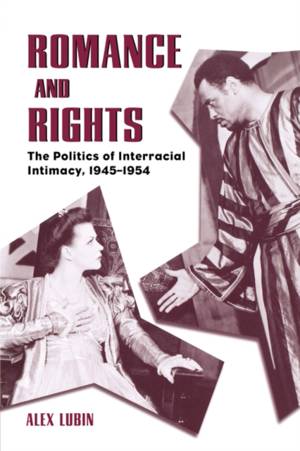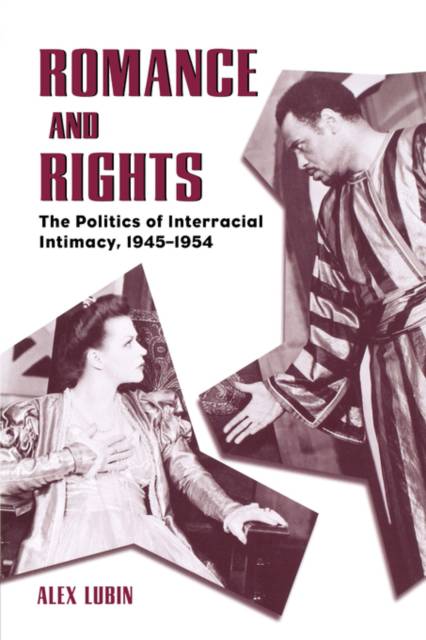
Bedankt voor het vertrouwen het afgelopen jaar! Om jou te bedanken bieden we GRATIS verzending (in België) aan op alles gedurende de hele maand januari.
- Afhalen na 1 uur in een winkel met voorraad
- In januari gratis thuislevering in België
- Ruim aanbod met 7 miljoen producten
Bedankt voor het vertrouwen het afgelopen jaar! Om jou te bedanken bieden we GRATIS verzending (in België) aan op alles gedurende de hele maand januari.
- Afhalen na 1 uur in een winkel met voorraad
- In januari gratis thuislevering in België
- Ruim aanbod met 7 miljoen producten
Zoeken
€ 59,45
+ 118 punten
Omschrijving
Romance and Rights: The Politics of Interracial Intimacy, 1945-1954 by Alex Lubin. Romance and Rights: The Politics of Interracial Intimacy, 1945-1954 is a major study of the meaning of interracial romance, love, and sex in the ten years after World War II. How was interracial romance treated in popular culture by African American civil rights leaders, soldiers, and white segregationists? Previous studies focus on the period beginning in 1967 when the Supreme Court overturned the last state antimiscegenation law (Loving v. Virginia). Alex Lubin's study, however, suggests that we cannot fully understand contemporary debates about "hybridity," or mixed-race identity, without first comprehending how WWII changed the terrain. The book focuses on the years immediately after the war, when ideologies of race, gender, and sexuality were being reformulated and solidified in both the academy and the public. Lubin shows that interracial romance, particularly between blacks and whites, was a testing ground for both the general American public and the American government. The government wanted interracial relationships to be treated primarily as private affairs to keep attention off contradictions between its outward aura of cultural freedom and the realities of Jim Crow politics and antimiscegenation laws. Activists, however, wanted interracial intimacy treated as a public act, one that could be used symbolically to promote equal rights and expanded opportunities. These contradictory impulses helped shape our current perceptions about interracial romances and their broader significance in American culture. Because Lubin is interested in this era of ideological shift among both whites and blacks, Romance and Rights ends in 1954, the year of the Brown v. Board of Education decision, before the civil rights movement became well organized. By closely examining postwar popular culture, African American literature, NAACP manuscripts, miscegenation laws, and segregationist protest letters, among other resources, the author analyzes postwar attitudes towards interracial romance, showing how complex and often contradictory those attitudes could be. Alex Lubin is a professor of American studies at the University of New Mexico.
Specificaties
Betrokkenen
- Auteur(s):
- Uitgeverij:
Inhoud
- Aantal bladzijden:
- 208
- Taal:
- Engels
Eigenschappen
- Productcode (EAN):
- 9781604732474
- Verschijningsdatum:
- 9/12/2004
- Uitvoering:
- Paperback
- Formaat:
- Trade paperback (VS)
- Afmetingen:
- 152 mm x 229 mm
- Gewicht:
- 312 g

Alleen bij Standaard Boekhandel
+ 118 punten op je klantenkaart van Standaard Boekhandel
Beoordelingen
We publiceren alleen reviews die voldoen aan de voorwaarden voor reviews. Bekijk onze voorwaarden voor reviews.









